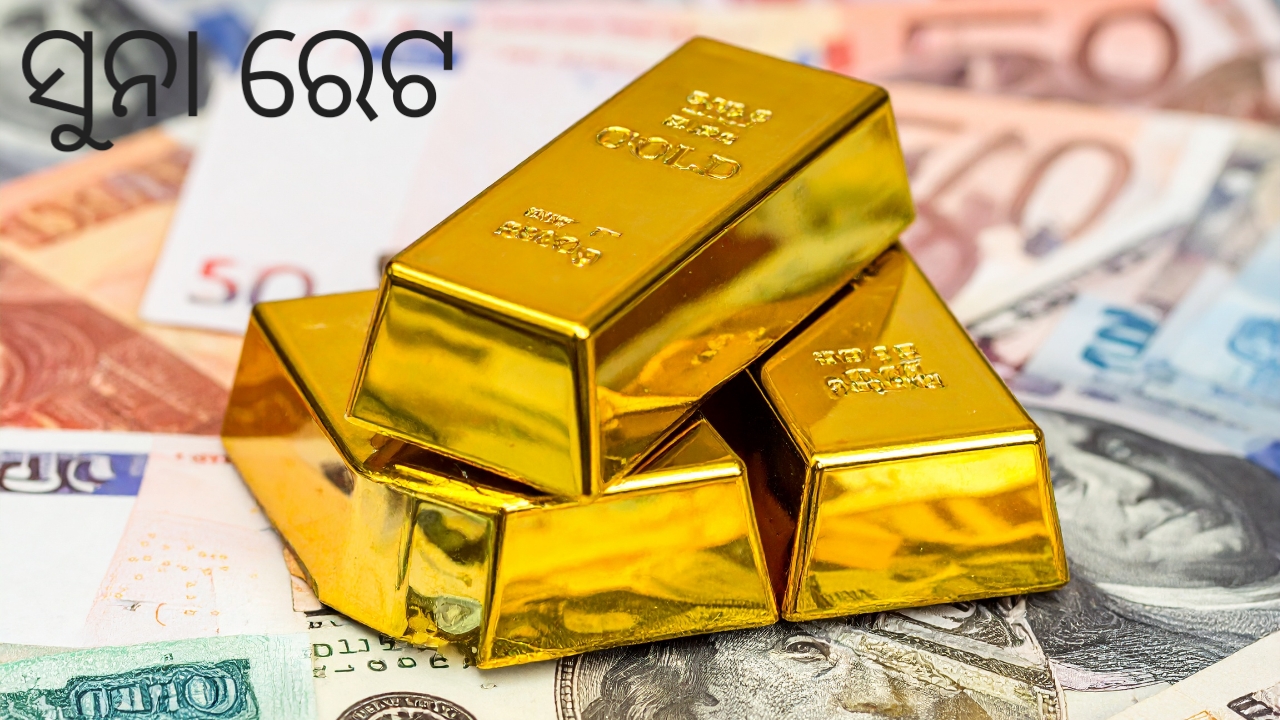ସୁନା ରେଟ today-ସୁନା ଦର,ଆଜିର ସୁନା ଦର
ସୁନା ରେଟ today:
| 1 gram | 10 gram |
| 9530 | 95309 |
ଆଜି ସୁନା ମୂଲ୍ୟ ପ୍ରତି ଗ୍ରାମ ₹୯୫୩୦, 24 କ୍ୟାରେଟ୍ ସୁନାରେ 99 ପ୍ରତିଶତ ସୁନା ଅଛି, ସୁନା ମୂଲ୍ୟ ବର୍ତ୍ତମାନର ବିଶ୍ୱ ଅର୍ଥନୈତିକ ପରିବେଶ (ସମସ୍ତ ମୁଦ୍ରାର ସାମଗ୍ରିକ ଅବମୂଲ୍ୟାୟନ), ବଜାର ଚାହିଦା ଏବଂ ଯୋଗାଣ, ନିବେଶକଙ୍କ ଆଚରଣ ଦ୍ୱାରା ପ୍ରଭାବିତ। ଆଜି ସୁନା ମୂଲ୍ୟ ଆପଣଙ୍କୁ ଭାରତରେ ସର୍ବଶେଷ ସୁନା ମୂଲ୍ୟ ପ୍ରଦାନ କରେ, ଆପଣଙ୍କ ସହରରେ କର ଏବଂ GST ଯୋଗୁଁ ସୁନା ମୂଲ୍ୟ ଭିନ୍ନ ହୋଇପାରେ। ସଠିକ୍ ଦୈନିକ ମୂଲ୍ୟ କିମ୍ବା କ୍ରୟ ଉଦ୍ଦେଶ୍ୟରେ, ସ୍ଥାନୀୟ ଅଳଙ୍କାର ବ୍ୟବସାୟୀ କିମ୍ବା ସୁନା ମୂଲ୍ୟ ଭଳି ଏକ ଅପଡେଟ୍ ହୋଇଥିବା ଆର୍ଥିକ ସମାଚାର ଉତ୍ସ ସହିତ ଯାଞ୍ଚ କରିବା ପରାମର୍ଶଦାୟକ। ଆଜି ଭାରତରେ ସୁନା ମୂଲ୍ୟ ଅନ୍ତର୍ଜାତୀୟ ବଜାର ଏବଂ ପରିବହନ ଯୋଗୁଁ ବୃଦ୍ଧି ପାଇଛି।है।

ସୁନା
ସୁନା ହାର ବା ସୁନାର ମୂଲ୍ୟ ଅନେକ କାରଣ ଦ୍ୱାରା ପ୍ରଭାବିତ ହୁଏ ଏବଂ ବଜାରରେ ଜଟିଳ ପାରସ୍ପରିକ କ୍ରିୟା ମାଧ୍ୟମରେ ନିର୍ଣ୍ଣୟ କରାଯାଏ। ଏଠାରେ କିଛି ପ୍ରମୁଖ କାରଣ ଅଛି ଯାହା ସୁନା ହାର ନିର୍ଣ୍ଣୟରେ ଅବଦାନ ରଖେ। ସୁନା ଦୀର୍ଘ ଦିନ ଧରି ବିଶ୍ୱର ସବୁଠାରୁ ଲୋଭନୀୟ ସାମଗ୍ରୀ ମଧ୍ୟରୁ ଗୋଟିଏ, ଏହାର ସୌନ୍ଦର୍ଯ୍ୟ ପାଇଁ ପ୍ରଶଂସିତ ଏବଂ ଏକ ସୁରକ୍ଷିତ ନିବେଶ ଭାବରେ ମୂଲ୍ୟବାନ। ଏହାର ମୂଲ୍ୟ, ଯାହାକୁ ପ୍ରାୟତଃ ସୁନା ହାର ଭାବରେ କୁହାଯାଏ, ଅର୍ଥନୈତିକ, ରାଜନୈତିକ ଏବଂ ବଜାର ଗତିଶୀଳତାର ଏକ ଜଟିଳ ଜାଲ ଦ୍ୱାରା ଚାଳିତ ବାରମ୍ବାର ପରିବର୍ତ୍ତନର ସମ୍ମୁଖୀନ ହୁଏ। ଏହି ପରିବର୍ତ୍ତନ ପ୍ରତିଦିନ କିମ୍ବା ଗୋଟିଏ ଦିନ ମଧ୍ୟରେ ମଧ୍ୟ ଘଟିପାରେ, ଯାହା ବାସ୍ତବ-ସମୟ ବଜାର ପରିସ୍ଥିତିକୁ ପ୍ରତିଫଳିତ କରେ। ସୁନା ମୂଲ୍ୟ ଗଠନ କରୁଥିବା ଏକ ଗୁରୁତ୍ୱପୂର୍ଣ୍ଣ କାରଣ ହେଉଛି ଅନ୍ତର୍ଜାତୀୟ ବାଣିଜ୍ୟ ପ୍ଲାଟଫର୍ମରେ ଏହାର ପ୍ରଦର୍ଶନ, ବିଶେଷକରି ନ୍ୟୁୟର୍କ, ଲଣ୍ଡନ, ସାଂଘାଇ ଏବଂ ମୁମ୍ବାଇ, ଦିଲ୍ଲୀ, ବାରାମତି ଭଳି ପ୍ରମୁଖ ସହରଗୁଡ଼ିକରେ। ପ୍ରତି ଆଉନ୍ସ ପ୍ରତି ସାଧାରଣତଃ ଉଦ୍ଧୃତ ବିଶ୍ୱ ହାର ଯୋଗାଣ ଏବଂ ଚାହିଦା ମଧ୍ୟରେ ସନ୍ତୁଳନ ଦ୍ୱାରା ସିଧାସଳଖ ପ୍ରଭାବିତ ହୁଏ। କେନ୍ଦ୍ରୀୟ ବ୍ୟାଙ୍କଗୁଡ଼ିକ, ଯେଉଁଠାରେ ଯଥେଷ୍ଟ ସୁନା ଭଣ୍ଡାର ଥାଏ, ଏହାର ବଜାର ଉପଲବ୍ଧତା ଏବଂ ଏହିପରି ଏହାର ମୂଲ୍ୟ ନିର୍ଦ୍ଧାରଣ ଧାରା ଉପରେ ଗୁରୁତ୍ୱପୂର୍ଣ୍ଣ ପ୍ରଭାବ ପକାଏ। ସୁନା ହାର ନିର୍ଣ୍ଣୟ କରିବାରେ ଆମେରିକୀୟ ଡଲାରର ଶକ୍ତି ମଧ୍ୟ ଏକ ପ୍ରମୁଖ ଭୂମିକା ଗ୍ରହଣ କରେ। ଯେହେତୁ ସୁନା ମୁଖ୍ୟତଃ ଡଲାରରେ ବ୍ୟବସାୟ କରାଯାଏ, ଏକ ଦୁର୍ବଳ ଡଲାର ଏହାକୁ ଅନ୍ୟ ମୁଦ୍ରା ଧାରକଙ୍କ ପାଇଁ ଅଧିକ ସୁଲଭ କରିଥାଏ, ଚାହିଦା ବୃଦ୍ଧି କରିଥାଏ ଏବଂ ମୂଲ୍ୟ ବୃଦ୍ଧି କରିଥାଏ। ବିପରୀତ ଭାବରେ, ଏକ ଶକ୍ତିଶାଳୀ ଡଲାର ସାଧାରଣତଃ ସୁନା ମୂଲ୍ୟ ଉପରେ ନିମ୍ନଗାମୀ ଚାପ ସୃଷ୍ଟି କରେ। ମୁଦ୍ରାସ୍ଫୀତି, ସୁଧ ହାର ଏବଂ ଭୂରାଜନୈତିକ ଅନିଶ୍ଚିତତା ଭଳି ଆର୍ଥିକ ସୂଚକ ସୁନା ମୂଲ୍ୟ ଭୂଦୃଶ୍ୟକୁ ଆହୁରି ଆକାର ଦିଏ। ଆର୍ଥିକ ଅସ୍ଥିରତା କିମ୍ବା ବୃଦ୍ଧି ପାଉଥିବା ମୁଦ୍ରାସ୍ଫୀତି ସମୟରେ, ସୁନାକୁ ଏକ ସୁରକ୍ଷିତ ସ୍ୱର୍ଗ ସମ୍ପତ୍ତି ଭାବରେ ବିବେଚନା କରାଯାଏ, ଯାହା ଫଳରେ ଚାହିଦା ଏବଂ ମୂଲ୍ୟ ବୃଦ୍ଧି ପାଏ। ଅନ୍ୟପକ୍ଷରେ, ବୃଦ୍ଧି ପାଉଥିବା ସୁଧ ହାର ସୁନାକୁ କମ୍ ଆକର୍ଷଣୀୟ କରିଥାଏ, କାରଣ ନିବେଶକମାନେ ସୁଧ-ଉତ୍ପାଦନକାରୀ ବିକଳ୍ପଗୁଡ଼ିକ ଆଡ଼କୁ ମୁହାଁଇପାରନ୍ତି। ଘରୋଇ ସ୍ତରରେ, ଆମଦାନୀ ଶୁଳ୍କ, ସ୍ଥାନୀୟ ଟିକସ ଏବଂ ମୁଦ୍ରା ବିନିମୟ ହାର ଭଳି କାରଣଗୁଡ଼ିକ ସୁନା ମୂଲ୍ୟକୁ ପ୍ରଭାବିତ କରେ। ଉଦାହରଣ ସ୍ୱରୂପ, ଭାରତରେ – ଏକ ପ୍ରମୁଖ ସୁନା ଗ୍ରାହକ – ପର୍ବ ଏବଂ ବିବାହ ଉତ୍ସବ ଭଳି ଋତୁକାଳୀନ ଧାରା ଚାହିଦା ବୃଦ୍ଧି କରିପାରେ, ଯାହା ପ୍ରାୟତଃ ମୂଲ୍ୟ ବୃଦ୍ଧି କରିଥାଏ। ନିବେଶ ଉଦ୍ଦେଶ୍ୟରେ, ଅଳଙ୍କାର କିମ୍ବା ଶିଳ୍ପ ପ୍ରୟୋଗ ପାଇଁ, ସୁନା ମୂଲ୍ୟ ଉପରେ ଅସଂଖ୍ୟ ପ୍ରଭାବକୁ ବୁଝିବା ଜରୁରୀ। ସୂଚନା ରହିବା ବ୍ୟକ୍ତିବିଶେଷଙ୍କୁ ଏହି ସ୍ଥାୟୀ ଏବଂ ମୂଲ୍ୟବାନ ସମ୍ପତ୍ତି ବିଷୟରେ ରଣନୈତିକ ନିଷ୍ପତ୍ତି ନେବାକୁ ଅନୁମତି ଦିଏ।
Yellow Gold Karat Information
91.6% Gold
75% Gold
58.5% Gold
Gold content percentages for yellow gold alloys.
୨୦୨୫ ମସିହାରେ ଭାରତରେ ସୁନା ମୂଲ୍ୟ
| जनवरी | 7800 प्रति ग्राम |
| फरवरी | 8800 प्रति ग्राम |
| मार्च | 8900 प्रति ग्राम |
୨୦୨୫ ମସିହାରେ ସୁନା ଦରରେ ଏକ ବଡ଼ ବୃଦ୍ଧି ଘଟିଛି, ଯେଉଁଠାରେ ଜାନୁଆରୀରେ ଏହା ପ୍ରତି ଗ୍ରାମ ୭୮୦୦ ଟଙ୍କା ଥିଲା, ଫେବୃଆରୀ ଏବଂ ମାର୍ଚ୍ଚରେ ଏହା ବୃଦ୍ଧି ପାଇ ୮୯୦୦ ଟଙ୍କା ପ୍ରତି ଗ୍ରାମ ହୋଇଛି। ଦିଲ୍ଲୀ, ମୁମ୍ବାଇ, ବାଙ୍ଗାଲୋର ଭଳି ଭାରତର ପ୍ରମୁଖ ସହରଗୁଡ଼ିକରେ ସ୍ଥାନୀୟ ଟିକସ ଏବଂ ମେକିଂ ଚାର୍ଜ ଯୋଗୁଁ ସୁନା ଦର ମହଙ୍ଗା ରହିଛି, ଅନ୍ୟପକ୍ଷରେ କୋଲକାତା, ଲକ୍ଷ୍ନୌ ଏବଂ ଚଣ୍ଡିଗଡ଼ ଭଳି ସହରରେ ସୁନା ଶସ୍ତାରେ ଉପଲବ୍ଧ, ହୀରା ଖଚିତ ଅଳଙ୍କାର ମହଙ୍ଗା,ଆଜି ଭାରତର ବିଭିନ୍ନ ଜିଲ୍ଲାରେ ସୁନା ଦର ଏବଂ ଭାରତର ସମସ୍ତ ଜିଲ୍ଲାର ସୁନା ମୂଲ୍ୟ ହେଉଛି ଅହମ୍ମଦନଗର, ଅକୋଲା, ଆଲାପୁଜା, ଆଲମୋରା, ଅନନ୍ତନାଗ, ଅନନ୍ତପୁର, ଅଞ୍ଜୱ, ଅରୱାଲ, ଆରାରିଆ, ଅଜମେର, ଅରଙ୍ଗାବାଦ, ଆଲିଗଡ, ଆମେଥୀ, ଅମୃତ, ଅମୃତ, ନାଗ ବାଗପାଟ, ବାହରାଇଚ, ବଲିୟା, ବଳରାମପୁର, ବୃନ୍ଦା, ବାରବାଙ୍କି, ବରେଲି, ବେତୁଲ, ଭାଗଲପୁର, ଭଣ୍ଡ, ଭୋପାଳ, ବିଲାସପୁର, ବକ୍ସାର, ଚମ୍ବା, ଚଣ୍ଡିଗଡ଼, ଚାନ୍ଦ uli ଲି, ଚିତ୍ରାକୁଟ, ଚରୁ, ଡାଟିଆ, ଦେହରାଡୁ, ଧରଗୁରୁ, ଦାରୁଗୁରୁ Hol ୋଲପୁର, ଦାମନ, ଡିୟୁ, ଦାର୍ଜିଲିଂ, ଡୋଡା, ଦରଭଙ୍ଗା, ଫତେହପୁର, ଫାରୁଖାବାଦ, ଫରିଦାବାଦ, ଫିରୋଜାବାଦ, ଫରିଦକୋଟ, ଗାଜିଆବାଦ, ଗାଜିପୁର, ଗଙ୍ଗାନଗର, ଗୋପାଳଗଞ୍ଜ, ଗୁରୁଗାଓଁ, ଗୋଣ୍ଡା, ଗ୍ୱାଲିଅର୍, ହରିଦ୍ୱାର, ହିସାର, ହାପୁର: କନ୍ନ uj ଜ, କାଟିହର, କଟକ, କର୍ଣ୍ଣଲ, କୋଲକାତା, କୋଟା, କୋରବା, କୁସିନାଗର, ଲକ୍ଷ୍ନ now, ଲଲିତପୁର, ଲୁଧିଆନା, ମଥୁରା, ମେରୁଟ, ମୁମ୍ବାଇ, ମୁଜାଫରନଗର, ମୁଜାଫରପୁର, ମୋରାଦାବାଦ, ନ ain ନିତାଲ, ନାଗନା, ନାଡନାପ, ଉନାଡନା ପ୍ରୟାଗରାଜ, ପ୍ରତାପଗଡ଼, ପିଥୋରାଗଡ, ପାଲି, ରାବେରେଲି, ରାୟଗଡ, ରାଜକୋଟ, ରତ୍ଲାମ, ରେୱା, ରୋହତସ୍, ରୋହତକ, ସାହାରା, ସାମସ୍ତିପୁର, ଶନି, ଶିବପୁରୀ, ସିର୍ସା, ସୋନଭଦ୍ର, ସୁଲତାନପୁର, ସୁରଟ, ଟନ୍କ, ଉଦାସପୁର, ବରଣ ବିଜୟୱାଡା, ବିଶାଖାପାଟନମ୍, ସାହାରନପୁର |
| साल | 24 कैरेट | 22 कैरेट | 20 कैरेट | 18 कैरेट |
| 1964 | 63.25 | 57.96 | 52.69 | 47.44 |
| 1965 | 71.75 | 65.74 | 59.76 | 53.81 |
| 1966 | 83.75 | 76.72 | 69.68 | 62.81 |
| 1967 | 102.5 | 93.86 | 85.42 | 76.88 |
| 1968 | 162.00 | 148.39 | 134.83 | 121.50 |
| 1969 |
